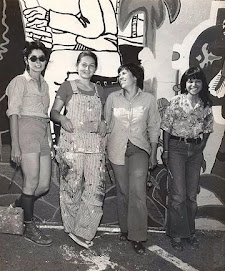Conde, Daniela - Week 8
 |
| |
So far we’ve had really great presentations in class highlighting Latinx/Xicanx artists, everyone has done a lot of work researching their artist and it shows. Living in San Diego, CA murals stand out to me so I decided to write this post on Graciela Carillo, who is an artist and muralist. Graciela is from Los Angeles, CA but she is known for her work in the Bay Area with the Mujeres Muralistas. I was drawn to this because as a collective they were able to do so much, they were all Chicanx/Latinx women who were showcasing their work in the Mission District. Their paintings reflected their culture, roots, histories and their people. The artists who were part of the Mujeres Muralistas included: Patricia Rodriguez, Irene Perez, Consuelo Mendez and of course Graciela Carillo. I decided to include a photo of them in this post. Based on the paint on the floor and their surroundings, they were possibly working on a mural together when this photo was taken. Muralism and public art has been/may still be a male dominated space, just like in the Bay Area this is also reflected in the Chicano Park history of murals, where men dominate the majority of the mural space. As a collective they were able to do a lot more and their work is definitely recognized among the public art in the Mission District. One of the murals our peer shared with us titled “Latinoamerica” highlights a lot of Indigenous elements, such as a pyramid made of maiz to show the importance of maiz to Indigenous peoples in Mexico and Central America in the past (and present day! ), among other beautiful vibrant details. I also came across this recording, digital archive, of Patricia Rodriguez speaking on the creation of the “Latinoamerica” mural which I thought was powerful: while they experienced some harassment from men in the streets “In general the Latino community was our primary audience and they let us know they were grateful. They brought us gifts of beer, tamales, and flowers for honoring them and their culture. They also brought their children to introduce them to their Latino heritage so they would not forget where they came from. The mural seemed to heal some of the community’s wounds.”

No comments:
Post a Comment